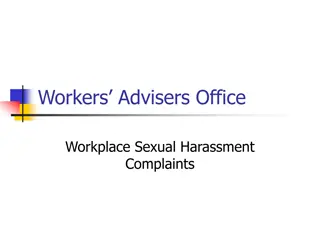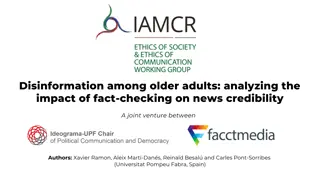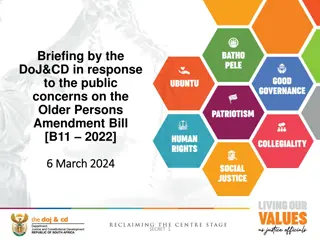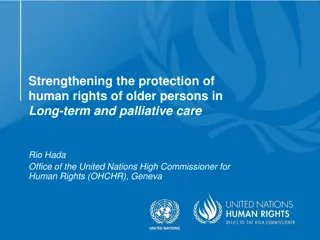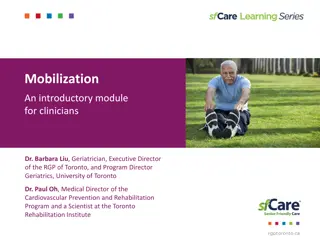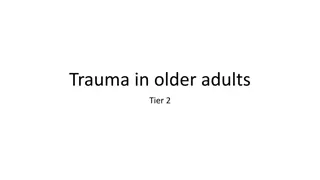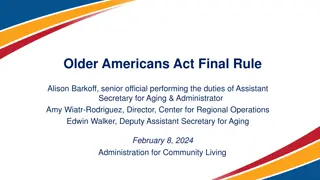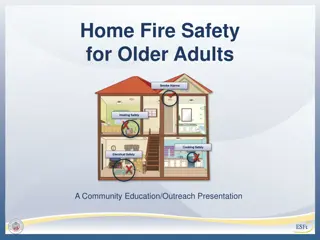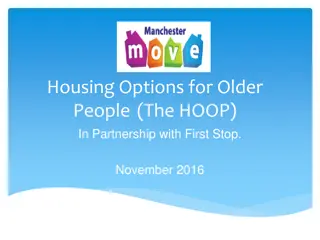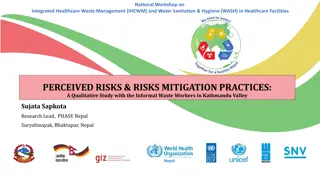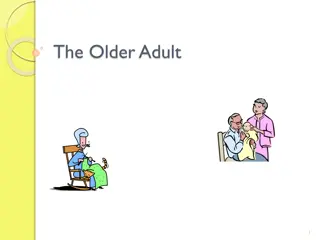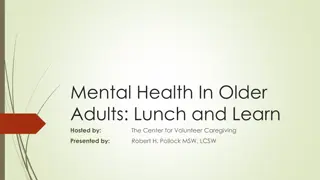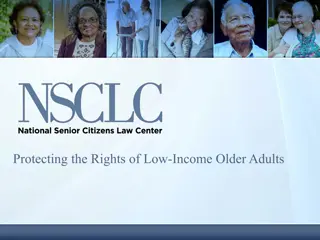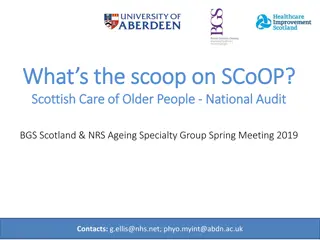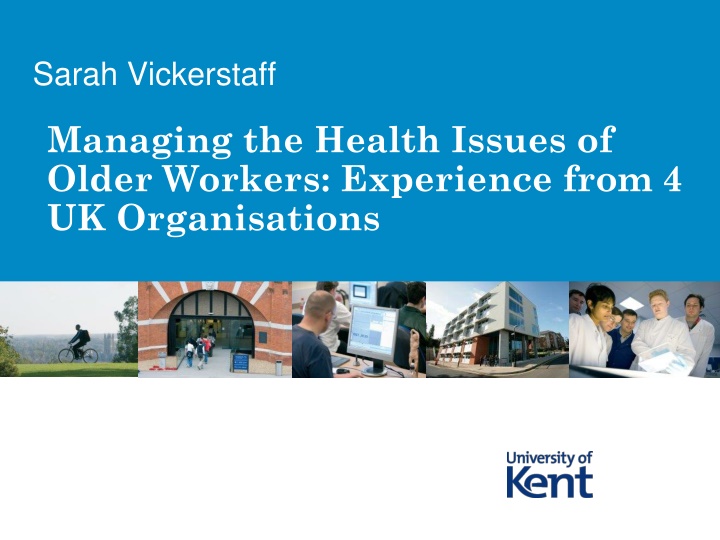
Managing Health Issues & Late-Career Transitions in UK Organizations
This research project explores strategies for managing the health issues of older workers and transitions in late careers in the context of policy developments and research objectives, emphasizing the importance of workplace well-being. The study involves multiple UK organizations and aims to understand factors influencing extended working lives and retirement transitions.
Download Presentation

Please find below an Image/Link to download the presentation.
The content on the website is provided AS IS for your information and personal use only. It may not be sold, licensed, or shared on other websites without obtaining consent from the author. If you encounter any issues during the download, it is possible that the publisher has removed the file from their server.
You are allowed to download the files provided on this website for personal or commercial use, subject to the condition that they are used lawfully. All files are the property of their respective owners.
The content on the website is provided AS IS for your information and personal use only. It may not be sold, licensed, or shared on other websites without obtaining consent from the author.
E N D
Presentation Transcript
Sarah Vickerstaff Managing the Health Issues of Older Workers: Experience from 4 UK Organisations
UNCERTAIN FUTURES: MANAGING LATE-CAREER TRANSITIONS AND EXTENDED WORKING LIVES This ESRC-funded mixed methods research, which links quantitative data (ELSA, HRS and NCDS) and organisational case studies, makes a distinctive contribution to our appreciation of the drivers and inhibitors for extending working life (EWL). Please visit our website: https://www.kent.ac.uk/extendingworkinglives/findings.html for articles and papers that elaborate on our findings Page 2
Policy Developments The last decade has seen unprecedented policy reform and development across a number of spheres which impacts upon EWL: Equalities legislation (2006) No default retirement age (2011) Changes to state pension ages (1995/2011/2014 ongoing) Pension reform and auto enrolment Welfare reform (incapacity benefit to employment support allowance) Flexible employment (2014) Page 3
Research Objectives Mapping existing and emerging late-career transitions using existing longitudinal data sets (ELSA/HRS). Identifying risk and protective factors affecting individuals during the transition from work to retirement (NCDS). Conducting case studies to understand the way in which processes associated with extended working life are negotiated within the workplace. Synthesising findings from quantitative and qualitative data to produce new models about the changing character of late-career transitions. Page 4
Why Look at Health? A shift in attitudes is necessary to ensure that employers and employees recognise not only the importance of preventing ill-health, but also the key role the workplace can play in promoting health and well- being . A new approach to health and well-being at work is now needed. Dame Carol Black, (2008) Working for a healthier tomorrow. Review of the health of Britain's working age population. London: TSO An ageing workforce and rising state pension ages give further urgency to the arguments she makes. Page 5
Case Study Participants CASE STUDY HR managers/ occupational health Line managers Employees Trade unions Local Government (LG) 5 9 37 Transport (TR) 6 6 19 2 Hospitality (HO) 3 5 22 Engineering and Manufacturing (MA) 13 5 29 1
Participant Characteristics Occupational Pension Membership % Labour Turnover CASE STUDY % Female % Blue Collar % Full time Major downsizing via VS/VER Local Government (LG) 14 78 54 92 68 100 Low Transport (TR) 37 100 Low for the sector 50 86 Hospitality (HO) 64 73 Engineering and Manufacturing (MA) 12 100 Low 23 100 Page 7
Approach to occupational health and key issues LG TR HO MA Organisation of Occupational Health function Outsourced three years ago Some In-house, some outsourced In-house In-house but outsourcing under discussion Focus on health and safety Low High (safety critical environment) Medium High (safety critical environment) Services Health screening Health screening Employee assistance programme (helpline) Physiotherapy Counselling Physiotherapy Health screening CBT Employee assistance programme (helpline) Key areas of referral Stress Chronic conditions: diabetes, heart disease Stress Musculoskeletal Musculoskeletal Stress/mental health Musculoskeletal Stress/mental health Page 8
Employee perspectives (1) Anxiety about ability to work to later state pension ages, especially for the lower paid Obviously your health, you know. It s got to be your health. Many times we sit here and we joke now, especially some of us that have been here 12 years or maybe longer and we ve seen changes, and the job sort of gets more and more demanding and physical, and you think, I can t see me doing this in another--, sometimes we think in another couple of years or five years, so I dread to think what we re going to be like if we ve got to stay to 67, because I know I won t be able to run around like I do now. (Female employee, HO) I d like to go pretty soon, actually, but I can t afford it. It basically comes down to money, really. I mean, you re not going to get much in the State Pension and, you know, they keep putting the age up and quite frankly, I can t see me physically and mentally being able to do this job, you know, at those ages they re talking about. I think it s 66 for me (Female employee, HO) Page 9
Employee perspectives (2) Health pessimism: It s very difficult to explain, but basically--, it d be great if you knew when your number was up. We don t. It d be great when you knew from one day to another how well you re going to feel in a few years time. But I think it just makes it more difficult in your decisions and is it going to be the right decision. (Female employee, LG) You know, they say people live longer. Yeah, okay, [both talking at once] I appreciate that, but I might be one of those people that die when they re 70. Like my father, he gave up work when he was 66, and died when he was 67. (Female employee, HO) Page 10
Employee perspectives (3) Wanting accommodations I think they need to be aware of that. They need to be aware of the issues that people, as they get older, are going to get. There could be jobs involved that you could sort of say, That's more suitable for an older person, that s got less screen involved in it. (Male employee, MA) Hiding health conditions So have you talked to your line manager about your osteoporosis? No. I ve kept it to myself and I know that s a bad thing and I shouldn t do it, but I cannot afford at this present time to lose my job . So really you just really have to hide the problems so that you can keep going.(Female employee HO) Page 11
Measures that could aid older workers Redeployment, reasonable adjustments Downsizing, safe havens Flexible work options, incl. home working Gradual or phased retirement Page 12
Day to day occupational health issues: In all organisations move towards wellbeing and proactive lifestyle initiatives but otherwise reactive approach In all organisations focus on absence management: That would appear to be from the stats that we see, that, you know, you re more prone to things going wrong or things needing attention or whatever [at older ages]. So that is a knock on effect of having an older workforce, actually going through all the managing attendance stuff and getting people in work and contributing. (Female line manager, LG) Opportunities for redeployment: high in Transport and Local Government, lower in Manufacturing and Hospitality No specific focus or new initiatives around older workers Page 13
The Availability of Flexible Options Whilst there were some good examples of flexibility around caring responsibilities, there was no specific focus on older workers. None of the organisations were monitoring take up of flexibility requests by age. So we don t get a lot of requests from the older workforce to work more--, some part time, but I wouldn t say particularly to work so flexibly. I would say that has been more among younger staff that are either to do with childcare or they ve wanted to go and study, so they ve wanted to do two days a week and not spread their hours over five days. (HR Manager HO). Highly dependent upon nature of work and current work pattern, female part time office workers or cleaners most likely to be able to modify hours downwards. Page 14
Losing Flexibility Due to Equalities Legislation We kind of tried to do it back in the 80s and 90s with--, we used to have what they call green carded drivers, so they could still drive trains but they couldn t go on the main line. So basically they were shunter drivers and they were doing the shunting in the yard. So there was a bit more walking around but you didn t have to concentrate on the main line stuff. And we had like a three link system, so the really, really earlies and really, really lates was down to the new guys, the ones coming up to retirement were on an easier shift. But now with equal opportunities, one shift really, so everyone does all--, green cards, they ve got rid of them now . (TR Operations Inspector). Page 15
Losing Flexibility Due to Commercial Pressures And it is very hard, and it s becoming more and more evident, trying to manage firstly staff expectations and also the numbers, because where we might have been able to do it before-so we might have decided there s an area that s slightly easier to clean. So this area you might determine is slightly easier than having to go into [ ] rooms and do up and downstairs, or kitchens and bathrooms. So whereas previously we might have been able to accommodate some staff still working but doing slightly less strenuous cleaning jobs, we haven t got those options any more, and that s what we re finding harder and harder. (HR manager, HO) Page 16
Phased or Gradual Retirement One organisation had a phased retirement scheme but it was not publicised and there was not widespread knowledge about it. Another organisation had got rid of its wind down scheme for people moving to retirement on the grounds that it might flout discrimination legislation. Our evidence suggests that the option of phased retirement is not widely known about or practised, and often depends upon informal exchanges with a sympathetic line manager. Page 17
Informal accommodations I mean, what I see is, when people become a little bit older, see, sensible managers, they seem to naturally help them migrate onto work that s done at a bench rather than working on the structure, for no particular reason and nothing s actually said about it, but it seems to happen that way anyway, and you hope that it happens that way, you know. (Male employee, MA) But potentially fragile: I know my previous line manager would have just said, Oh, just go on, [laughs] sort of thing, you know, but with this line manager everything is completely by the book. Which, you know, at the end of day, that s what you re supposed to do and the rest of it. But it does throw up some anomalies really and like I say, next week, I m using one of my day s holiday [for a medical appointment] (Male Employee LG) Page 18
Conclusions In organisations with a good approach to occupational health (OH) issues still no explicit focus on older workers OH still oriented towards traditional role of treating/assessing and exiting the fallen Older workers anxious about rising state pension ages and whether their health will hold out Operational pressures mean that good policies may not be implemented Good line managers and other colleagues may make informal arrangements but these are fragile Defensive reaction to equalities legislation may actually be frustrating initiatives for older workers Page 19
Thank You! Thanks to all the people involved with the project: Ben Baumberg-Geiger, Amanda Burns, Charlotte Clark, Joanne Crawford, Amanda Fahy, Mariska van der Horst, David Lain, Wendy Loretto, Chris Phillipson, Mark Robinson, Sue Shepherd, David Wainwright, Andrew Weyman Page 20


